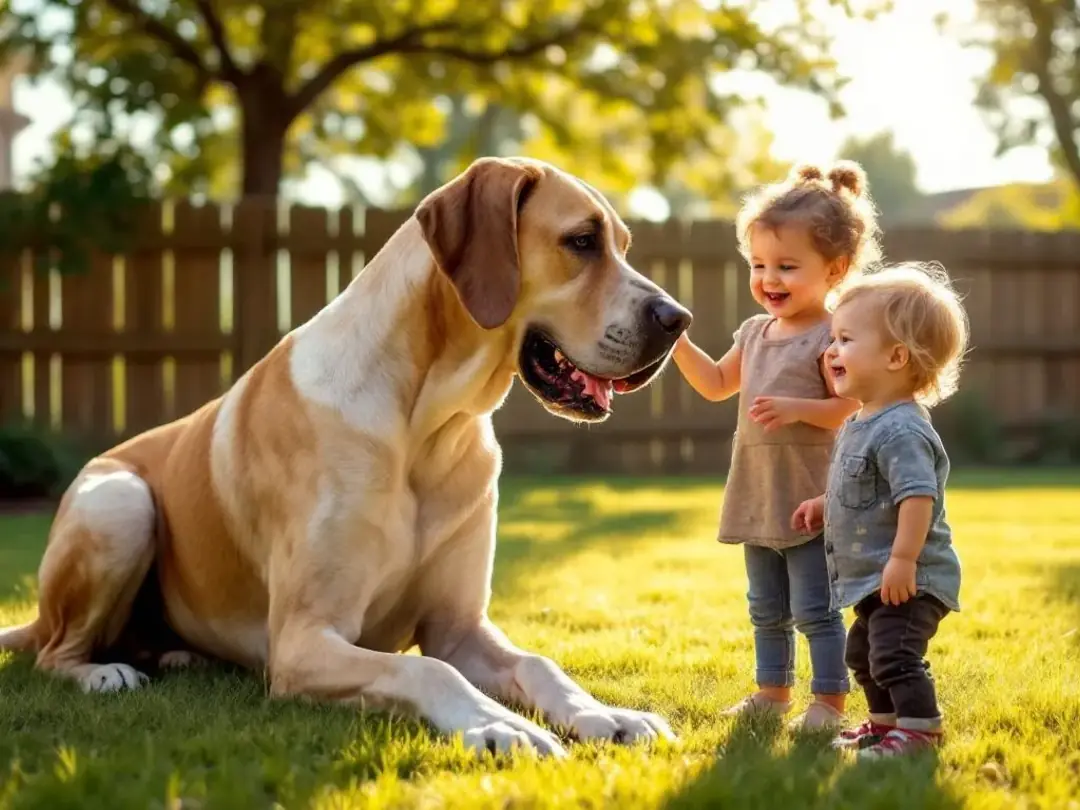Key Takeaways
-
Calm dog breeds exhibit measured responses to stimuli without stress or aggression, making them ideal for families with children and therapy work
-
These peaceful breeds range from small lap dogs like Cavalier King Charles Spaniels to gentle giants like Saint Bernards and Newfoundlands
-
Most calm breeds require early socialization and consistent training to develop their naturally serene temperaments
-
While generally low-energy, many calm breeds still need regular exercise and mental stimulation to maintain their balanced personalities
-
Calm dog breeds are particularly well-suited for apartment living, senior owners, and households seeking peaceful, loyal companions
What Makes a Dog Breed Calm
A calm dog breed exhibits specific temperament traits that set them apart from their more excitable cousins. According to American Kennel Club standards, these dogs demonstrate measured responses to new people, unfamiliar sounds, and changing environments without showing stress-induced behaviors like excessive barking or hyperactivity.
The most calm dog breeds share several key characteristics. They maintain low baseline activity levels indoors, show even responses to sudden stimuli, and display minimal inclination to startle or react aggressively without clear provocation. These traits make them adaptable to various living situations, from busy family homes to quiet apartments.
Breeding history plays a crucial role in developing these serene temperaments. Many of today's calmest dogs were originally bred for roles requiring patience and steady nerves. Golden retriever and labrador retriever lines, for example, were developed to work closely with humans in hunting situations where impulsiveness could ruin the hunt. Similarly, saint bernards needed calm dispositions to perform mountain rescue work effectively.
It's important to understand that individual personality variations exist within every breed. While breed standards provide guidelines, factors like early socialization, training consistency, and environmental influences significantly impact a dog's eventual temperament. Even the most naturally calm dog breed benefits from proper socialization and positive reinforcement to reach their full potential as peaceful companions.
The benefits of choosing calm dogs extend far beyond simple household tranquility. These gentle demeanor breeds excel in therapy work, providing comfort in hospitals and care facilities. They make great family pets for households with small children, elderly family members, or other pets who might be overwhelmed by more energetic dogs.
Gentle and Intelligent Calm Dog Breeds
When searching for the perfect calm dog breed, families often look for a companion that is not only peaceful but also gentle and intelligent. The calmest dog breeds, such as the beloved Golden Retriever, are renowned for their gentle demeanor and ability to get along harmoniously with other dogs, cats, and children. These breeds are a wonderful fit for both first-time pet parents and active pet parents who want a loyal friend that brings tranquility to the home.
The Labrador Retriever stands out as a classic example of a calm dog breed that combines intelligence with a loving personality. As one of the most popular sporting dogs, Labradors are eager to please, easy to train, and adapt well to a variety of environments-making them a great family pet for households with kids or other pets. Their even tempered nature and affectionate disposition mean they thrive in both active and laid back households.
Gentle giants like the Great Dane and Saint Bernard are often described as the calmest dogs, despite their impressive size. These breeds are known for their mild mannered personalities and gentle approach to life, making them ideal companions for families with small children. Their calm presence and protective instincts offer both comfort and security, while their affectionate nature ensures they become beloved members of the family.
For those seeking a smaller companion, breeds like the Cavalier King Charles Spaniel and Basset Hound offer a perfect match. Cavaliers are good natured, affectionate, and love to play, making them excellent lap dogs for families with kids. Basset Hounds, with their laid back attitude and independent streak, require patient training but reward their owners with unwavering loyalty and a lovable, cuddly personality.
Other calm dog breeds, such as the Greyhound, Clumber Spaniel, and Bichon Frise, are celebrated for their quiet, even tempered personalities. Greyhounds, despite their history as racing dogs, are surprisingly calm and content to lounge quietly at home. Clumber Spaniels are intelligent and gentle, thriving in family environments where they can form strong bonds with their humans. The Bichon Frise, with its cheerful and affectionate nature, is a low maintenance, cuddly companion that fits well into a variety of living situations.
When considering a calm dog breed, pet parents should think about factors like energy level, grooming needs, and trainability. Many of these breeds are highly intelligent and respond well to positive reinforcement training, making them easy to integrate into family life. Their low to moderate exercise requirements and adaptable personalities mean they can live happily in apartments or houses with yards, as long as their emotional and physical needs are met.
Ultimately, gentle and intelligent calm dog breeds offer the best of both worlds: a peaceful, loving presence and a smart, trainable companion. With their loyal hearts, affectionate personalities, and laid back approach to life, these breeds are sure to bring joy, comfort, and companionship to families for many years to come.
Small Calm Dog Breeds (Under 25 pounds)
Small calm dog breeds pack tremendous personality into compact packages, making them perfect apartment dog choices for pet parents seeking gentle, manageable companions.
Cavalier King Charles Spaniel
The cavalier king charles spaniel represents the epitome of calm lap dogs. Originally bred as companions for English royalty during the Renaissance, these dogs were specifically selected for their sweet expression and gentle demeanor. Their history with nobility shows in their naturally good natured approach to strangers and new people.
These affectionate dogs typically weigh 12-18 pounds and possess the classic "eager to please" personality that makes training straightforward. They're particularly excellent with small children, often following family members around like devoted shadows. However, this loyalty means they can develop separation anxiety if left alone for extended periods.
Pekingese
Originally bred for Chinese emperors, the Pekingese carries themselves with regal independence while maintaining a fundamentally calm temperament. These small dogs prefer quieter households and may not be the perfect match for families with very young kids who might overwhelm their more reserved personality.
Weighing 7-14 pounds, Pekingese adapt well to apartment living and require only moderate exercise. Their flat snout means they're prone to overheating, so active pet parents need to adjust expectations and provide shorter, cooler walks.
Tibetan Spaniel
Buddhist monasteries developed Tibetan Spaniels as watchful but gentle companions. These medium sized small dogs (9-15 pounds) balance playful energy with calm observation, making them excellent for apartments while still maintaining enough personality to engage with families.
Bichon Frise
The Bichon Frise combines a friendly white powder-puff appearance with an easy going temperament that responds beautifully to positive training. These intelligent dogs shed minimally and adapt well to various living environments, though they do require regular grooming to maintain their distinctive coat. The Bichon Frise is especially cute, with its charming looks and playful personality making it a favorite among those seeking an adorable companion.
French Bulldog
With their distinctive bat ears and quiet nature, French Bulldogs have become popular apartment dog choices. These mild mannered companions need minimal exercise due to their brachycephalic features but offer maximum personality and loyalty in return.


Medium Calm Dog Breeds (25-60 pounds)
Medium-sized calm breeds offer the perfect balance-substantial enough to feel secure but manageable enough for most living situations.
Basset Hound
Basset hounds exemplify the laid back personality that makes them beloved family companions. Originally bred as French scent hounds, these dogs maintain their exceptional nose for tracking while displaying remarkably calm temperaments around children and other pets.
These gentle giants (in personality, not size) typically weigh 40-65 pounds and require moderate exercise-a couple of daily walks satisfy their physical needs while their low energy indoor behavior makes them excellent house dogs. Their patient nature with small children has made them popular choices for growing families.
English Bulldog
Don't let their muscular appearance fool you-English Bulldogs possess kind hearts wrapped in protective-looking packages. These dogs prefer lounging to lengthy activities and adapt beautifully to apartment living, though pet parents must monitor them carefully in warm weather due to their flat snout.
Whippet
Racing dogs by heritage, Whippets surprise many people with their calm indoor behavior. After brief bursts of exercise (they are sporting dogs, after all), these sleek companions transform into quiet couch companions who appreciate gentle households and consistent routines.
Clumber Spaniel
Dating back to 1700s England, clumber spaniels bring loyal, reliable temperaments to active families who appreciate their strong work dedication balanced with even tempered home behavior. These intelligent dogs respond well to training and form strong bonds with their human families.
Cocker Spaniel
Gentle sporting dogs with naturally affectionate personalities, Cocker Spaniels demonstrate the sweet temperament that made them popular family pets for generations. They tend to form particularly strong family bonds while maintaining friendly attitudes toward strangers and new environments.


Large Calm Dog Breeds (60+ pounds)
Large calm dog breeds often earn the "gentle giants" nickname through their combination of impressive size and remarkably gentle dispositions.
Saint Bernard
Saint bernards trace their lineage to Alpine rescue work beginning around 1050, where their gentle disposition despite imposing size (often reaching 200 pounds) proved essential for helping stranded travelers. These dogs maintain that same calm, protective temperament in modern family environments.
Their patient nature with children is legendary, though their substantial size means supervision remains important around a small child who might be accidentally knocked over during play. Saint bernards require regular exercise but prefer moderate activities to high-intensity games.
Newfoundland
Sweet-tempered Canadian breeds developed for water rescue, Newfoundlands excel with children and demonstrate remarkable patience in family settings. These lovable dogs require regular swimming exercise when possible, as their webbed feet and water-resistant coats reflect their aquatic heritage.
Weighing 100-150 pounds, Newfoundlands need plenty of space and long daily walks, but their calm indoor temperament makes them surprisingly adaptable to various living environments as long as exercise needs are met.
Irish Wolfhound
Despite reaching 32 inches tall, Irish Wolfhounds possess sensitive natures that make them excellent therapy work candidates. These gentle giants require experienced owners who understand their space needs and exercise requirements, but reward families with incredibly loyal, quiet companionship.
Great Dane
Great danes combine friendly personalities with surprisingly quiet temperaments, earning their place among the most beloved gentle giants. These dogs need plenty of space for their substantial frames and benefit from long daily walks, but their mild mannered indoor behavior often surprises first-time owners.
Boerboel
South African mastiffs with calm temperaments around children, Boerboels require experienced owners who can provide proper training and socialization. Boerboels are considered large guard dogs, historically bred to protect homesteads and valued for their vigilance and imposing presence. While naturally protective, well-bred Boerboels demonstrate the even tempered nature that makes them excellent family guardians when properly managed.
Special Considerations for Calm Breeds
Calm doesn't automatically mean low-maintenance. Understanding the specific needs of peaceful breeds helps ensure they live their best life while maintaining their naturally serene dispositions.
Exercise Requirements
Many pet parents mistakenly assume calm dogs need minimal exercise, but most calm dog breeds still require daily physical activity to maintain their balanced personalities. Clumber spaniels, despite their laid back nature, were bred as hunting dogs and benefit from regular walks and mental stimulation.
The key difference lies in exercise style rather than quantity. While high-energy working breeds like the border collie might need intense agility training and vigorous activity, calm dogs typically prefer consistent, moderate activities. Two shorter walks often work better than one long session, protecting joints while providing necessary stimulation.
Training Approaches
Positive reinforcement techniques work exceptionally well with gentle temperaments. These intelligent dogs respond beautifully to patient, consistent training that builds on their natural desire to please their humans. Harsh corrections often backfire with sensitive calm breeds, potentially undermining their confidence.
Early socialization remains crucial even for naturally peaceful dogs. Exposure to various environments, strangers, and other animals during puppyhood helps maintain their calm behavior throughout life while preventing anxiety or fearfulness.
Living Space Considerations
While many calm breeds adapt well to apartments, size matters for giant breeds. Great danes and saint bernards need adequate space for their substantial frames, even if their temperament suits smaller living situations.
Consider breed-specific needs: brachycephalic breeds like English Bulldogs struggle with stairs and heat, while long-coated breeds require more grooming attention to prevent matting and maintain comfort.
Health Monitoring
Calm breeds often face specific health challenges. Brachycephalic breeds may develop breathing difficulties, while giant breeds face increased risks of bloat and joint problems. Regular vet checkups help catch issues early, and understanding breed-specific concerns helps pet parents provide appropriate preventive care.
Many calm dogs tend toward weight gain due to lower activity levels, making careful diet management essential for long-term health and mobility.


Choosing the Right Calm Breed for Your Family
Finding the perfect match requires honest assessment of your lifestyle, living situation, and long-term commitment capacity.
Matching Energy Levels
Consider your daily routine and activity preferences. If you enjoy long hiking adventures, a Whippet might provide the right balance of calm home behavior with occasional bursts of exercise enthusiasm. Families preferring gentle strolls might find basset hounds or English Bulldogs better suited to their pace.
Active pet parents sometimes assume they need high-energy dogs, but many find calm breeds provide perfect companionship without the constant stimulation requirements of working breeds like border collies.
Space and Environment
Apartment living works well for many small to medium calm breeds, but giant breeds need room to stretch comfortably. French Bulldogs and cavalier king charles spaniels adapt beautifully to smaller spaces, while great danes require homes with adequate room for safe movement.
Consider your neighborhood environment too. Calm dogs often adapt well to urban settings with proper socialization, but some may prefer quieter suburban environments with less constant stimulation.
Family Composition
Households with small children benefit from naturally patient breeds like saint bernards or golden retrievers, though supervision remains important regardless of breed temperament. Elderly family members often appreciate the gentle, predictable nature of calm dogs that won't knock them over with enthusiasm.
Multi-pet households should consider how different animals interact. Most calm dog breeds get along well with cats and other dogs, but individual personalities and proper introductions matter more than breed generalizations.
Experience Level Considerations
First-time dog owners often thrive with calm breeds due to their generally predictable, manageable temperaments. However, giant breeds like Boerboels may require more experienced handling despite their calm nature, due to their size and potential protective instincts.
Research breed-specific needs and connect with reputable breeders who can match individual puppies to appropriate families based on personality assessment rather than just breed characteristics.


Training and Care Tips for Calm Dogs
Maintaining and nurturing your calm dog's peaceful temperament requires understanding how to work with their natural inclinations rather than against them.
Positive Reinforcement Strategies
Calm dogs typically respond exceptionally well to gentle, consistent training approaches. Use treats, praise, and play as rewards for desired behaviors, building on their natural eagerness to please their human friends. Keep training sessions short and positive-most calm breeds prefer learning through patient repetition rather than intensive drilling.
Focus on basic cues that enhance daily life: reliable recall, polite greetings with strangers, and calm behavior around other pets. These dogs often excel at therapy work precisely because they respond so well to structured, positive training environments.
Socialization for Calm Temperaments
Even naturally peaceful dogs need exposure to various environments, people, and animals during their critical socialization period. The goal isn't to make them more active, but to ensure they remain confident and calm in new situations throughout their lives.
Plan controlled exposures to friendly people, different surfaces, gentle sounds, and well-behaved other dogs. Keep sessions short and positive, allowing your pup to approach new experiences at their own pace while providing encouragement and treats for calm, curious behavior.
Exercise and Mental Stimulation
Tailor activities to your breed's natural inclinations. Swimming works wonderfully for Newfoundlands, while basset hounds might prefer scent-based games that engage their hunting heritage. The goal is providing appropriate outlets for their energy without overstimulation.
Mental challenges often tire calm dogs more effectively than physical exercise alone. Puzzle feeders, basic training games, and supervised exploration of new environments provide the brain work these intelligent dogs crave.
Maintaining Peaceful Environments
Create consistent routines that support your dog's calm nature. Regular meal times, predictable walk schedules, and quiet spaces for rest help maintain their naturally serene dispositions. Many calm breeds thrive on routine and may become anxious when their environment becomes too chaotic.
Monitor for signs of stress or overstimulation, such as excessive panting, restlessness, or withdrawal. Calm dogs often mask discomfort well, so attentive pet parents learn to read subtle signals and provide appropriate support when needed.
FAQ
Are calm dog breeds naturally good with cats and other small animals?
Most calm dog breeds adapt well to multi-pet households due to their generally peaceful temperaments and lower prey drive. However, individual personality, early socialization, and proper introductions matter more than breed generalizations. Breeds like cavalier king charles spaniels and golden retrievers typically integrate well with cats, while some hunting breeds may retain stronger chase instincts despite their calm nature.
Do calm dogs make effective guard dogs or provide any protection?
While calm dogs aren't typically aggressive protectors, many provide excellent alert systems through their natural tendency to notice changes in their environment. Large calm breeds like great danes and saint bernards can deter intruders simply through their imposing presence, while their loyal nature means they'll often position themselves between their family and perceived threats. However, families seeking active protection should consider breeds specifically developed for guard work rather than relying on calm breeds' protective instincts.
How do I know if a calm breed puppy will maintain their peaceful temperament as they mature?
A puppy's adult temperament depends on genetics, early socialization, and consistent training rather than just breed tendencies. Look for responsible breeders who test parent dogs' temperaments and provide early socialization experiences. Even naturally calm breeds require ongoing positive training and appropriate mental stimulation to develop into well-adjusted adults. Meeting parent dogs and observing how puppies respond to handling, new experiences, and gentle stimulation can provide insights into their likely adult personalities.
Can calm dog breeds live successfully in busy, noisy urban environments?
Many calm breeds adapt well to city living with proper socialization and gradual exposure to urban stimuli. Their naturally lower reactivity to sudden sounds and environmental changes often makes them more suitable for apartment living than high-energy breeds. However, they still need quiet spaces for rest and recovery from stimulation. Breeds with breathing difficulties (like French Bulldogs) may struggle more with air quality and temperature extremes common in urban environments.
What's the difference between a naturally calm dog and a lethargic or unhealthy dog?
Healthy calm dogs show interest in their surroundings, respond appropriately to interaction, and demonstrate normal appetite and bathroom habits. They engage in play and exercise according to their breed's typical energy levels, even if those levels are moderate. Lethargy, on the other hand, involves unusual disinterest in normal activities, changes in eating or sleeping patterns, or reluctance to engage in previously enjoyed activities. Regular vet checkups help distinguish between natural temperament and potential health issues, especially important for calm breeds that may mask discomfort well.






